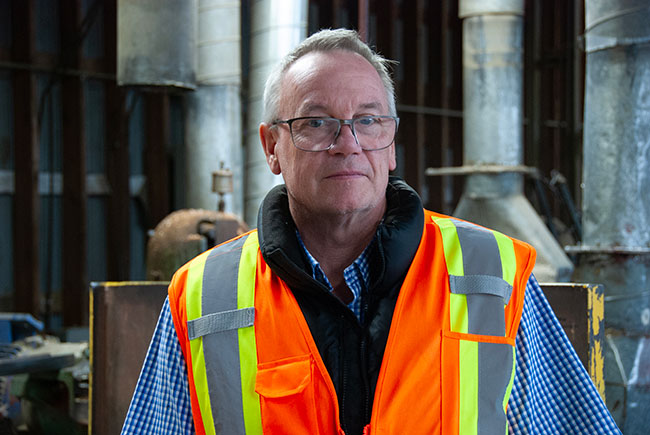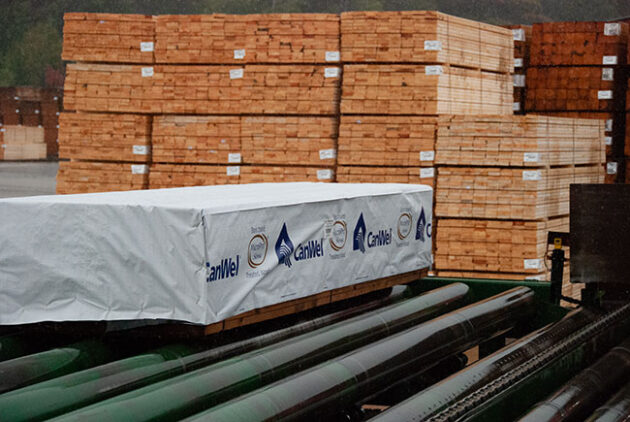
Features
Remanufacturing
Pastway Planing: Weather tight
January 15, 2024 By Maria Church
 Peter Hattin is the general manager of Eastern Canada for the CanWel Treating Division and a long-time employee at Pastway Planing.
Peter Hattin is the general manager of Eastern Canada for the CanWel Treating Division and a long-time employee at Pastway Planing.
A reman and wood treatment facility in southern Ontario is going on half a century setting high industry standards and their secret recipe is a mixture of good timing, chemistry and employees.
Pastway Planing is among Canada’s only wood treatment facilities that also has a complementary planing plant. The facility in Combermere – a two-hour drive west of Ottawa – sits in the Ottawa Valley wood basket, allowing access to a steady, year-round supply of softwood plantation trees.
The site will treat around 65 million board feet, and dress about 45 million board feet of predominantly red pine each year, with some hardwoods as well.
Pastway was acquired by CanWel – one of Canada’s largest wood treatment players – in 2013. Today, more than 70 employees keep the operation running, many of which have been with the company for 20 years or more.
Peter Hattin, general manager of Eastern Canada for the CanWel Treating Division, is among the long-time Pastway employees and has had a front-row seat to the changing forest industry in central Ontario. While many companies specialized to maintain competitive margins, Pastway integrated vertically and kept its planing facility in full operation.
A big factor of the plant’s recent success was a well-timed “calculated business risk” that Hattin took in 2012, just before the CanWel acquisition, to introduce a new preservative treatment that, as they now say with pride, changed the treated wood market from green to brown.
Market leader
Pastway holds bragging rights as the first to market with a pressure treatment preservative that offered, for the first time, a better alternative to traditional green pressure treated lumber in Canada: MicroPro Sienna, or micronized copper azole (MCA), from Timber Specialities.
Wood treated with MCA is a warm, natural brown colour. The new preservative not only bucked the green colour standard, it also halved the environmental footprint of traditional treated wood. The treatment process uses less energy, is more environmentally friendly, and has lower greenhouse gas emissions than the standard treatment process.
Timber Specialities – the Canadian arm of U.S.-based Koppers – developed and researched this brand-new wood preservative in early 2010s, and worked with Pastway to bring it to market.
On Nov. 12, 2012, the first piece of treated MCA lumber came off the line for market at Pastway. The day marked the beginning of a market upset with a brand-new wood preservative.
“We changed the pressure treated wood market to brown,” says Jana Proctor, marketing manager with Timber Specialties. “Consumers didn’t want green PT anymore, they wanted brown. We forced the market to switch to brown.”
While MCA wasn’t exclusive to Pastway, the goal at the time was to get ahead of the curve, Hattin says. The company led the product to market, producing more than 30 million board feet of MCA treated wood in the first year. Being first to market was key to the success of launching the new brand, MicroPro Sienna.
Mobile fleet
- 5 Volvo and Hyundai loaders
- 5 LiftKing rough terrain forklifts
- 3 CAT, Toyota and Hyster standard forklifts
- 1 Champion grader
- 1 GMC sander/water tanker truck
- 1 Kenworth W900 transport truck
Treatment flow
With a focus on locally sourced red pine, Pastway’s preserved wood products are sold in building material retailers throughout Ontario and western Quebec.
All fibre entering Pastway’s gates is bundled lumber or cants, either surface-green or surface-dry.
Bundles heading to the treatment facility are first unwrapped and prepped for treating. All staples are removed and a visual grader pulls any low quality boards. A custom-built automated stacker nests the pre-treated lumber with large stickers to allow for optimal treatment and air flow. Staff also hand-applies the end tags at this stage.
The stacks are then be moved by forklift to the infeed of an entirely self-contained treatment facility. A forklift inside the facility transfers the stacks onto the infeed tracks of one of two retorts – 80-foot long, six-foot round cylinders from J.H. Lock. Once a charge of product is loaded into the retort, it fills with solution and is put under pressure and heat for between 60 and 90 minutes, depending on the product and temperature. Two Boilersmith boilers supply heat for the process.
The MCA chemical solution – a special combination of registered preservatives, pigments, dyes and moldicide – is blended for each charge and results are checked regularly throughout the day by the facility manager ensuring a tight quality control program from start to finish.
Once the treatment cycle is complete, a negative vacuum removes the remaining liquid, which is then recirculated for the next charge. The treated stacks are then moved to a drip pad in the facility and will sit for a minimum of 48 hours before they are manually wrapped and moved to the yard for storage. The treatment process is kept as homogenous as possible, Hattin says. “We don’t want to overtreat and we don’t want to undertreat.” They work hard to segregate the different products into separate charges to undergo the right level of time, pressure and chemical solution.

Pastway Planing treats around 65 million board feet, and dresses around 45 million board feet a year.
Planing flow
Much of Pastway’s planing plant is still a manual process, which Hattin says is a decision to remain flexible and adaptable to customer orders. Customers expect quality, and so jobs such as grading are all visual.
Most fibre arrives on site as squares and is milled into products from 1×2 up to 8x8s, with some speciality jobs creating products up to 40 feet.
For their 2-inch dimensional products, boards are first sent across a custom built 100-foot grading line with an auto stacker and Samuel strapping machine.
The planing plant has three Yates A20 planers, each of which is fed with TS Machinery-built tilt hoist. Operators watch to remove off-spec boards both before and after the planer. Line 1 has a Stetson-Ross XLRipper1 and lines 2 and 3 have Yates-American bandsaw resaws, one of which was reconditioned by TS Machinery. Boards are then manually stacked using lath either purchased or made on site from a Stetson-Ross XLRipper1 multi-rip saw.
All residuals from the planer mill are dried in a drum dryer and sold as shavings for animal bedding.
Planning ahead
With products mainly destined for home improvement stores, and much of it for decking, Hattin notes they have a short selling season and must carefully plan for it.
“Everyone wakes from their winter doldrums and is itching to do a backyard project,” Hattin says. By September, backyard renovations are done, the nice weather is gone and the demand dries up. Pastway meticulously manages its resources to account for the anticipated boom and bust of that season. Keeping the planer process manual allows for the flexibility to shift products as needed.
The “covid years” threw a wrench in that pattern, with the renovation market exploding and extreme volatility – the new normal. “We had to tighten down our inventory and wait it out,” Hattin says. “I think we’ve come back to stability here, but we’ve all gone through 30 months of extreme ups and downs.”
Expertly navigating the tumult allowed Pastway to continue employing its full complement of staff today, many of whom are like family. For Hattin, being able to keep the facility’s most valuable resource, its people, employed full-time during challenging times is what drives them to be market leaders.
Pastway Planing has a very humble beginning with Ray Pastway and even before, with his father Frank in the 1930s.
“It started out as a small family operation and, as it grew and became a market leading dominant player in the treated industry, the company has not waivered in keeping focused on looking after its most cherished resource, its people. While they all have different last names, they are still family with a solid work ethic and that is what makes this such a successful company,” Hattin says. “And I cannot see anything but great things for Pastway Planing and its employees in the years to come. The future looks bright and we will welcome any challenge that comes our way.”
Print this page